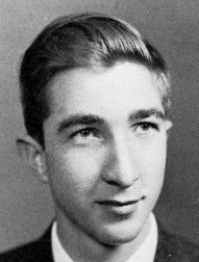Collection includes late writer’s reviews, letters, manuscripts
 | John Updike, as a senior at Harvard, in 1954. |
Harvard University has acquired the manuscripts, correspondences, and other papers of John Updike, a celebrated member of the Class of 1954 who kept a Harvard library card and frequently visited the campus to research the contemporary culture that enlivened his acclaimed fiction.
The university will announce today that Houghton Library, Harvard’s primary repository for rare books and manuscripts, will house the John Updike Archive, making the library the center for studies on the life and work of the two-time Pulitzer Prize winner and prolific novelist, poet, and critic. College officials would not disclose how much Harvard paid to acquire the papers of Updike, who died in January at 76.
“John Updike is a terribly important American, given his cultural and literary achievement,’’ said William Pritchard, an English professor at Amherst College who chronicled the writer’s life and work in “Updike: America’s Man of Letters.’’ “It’s an extraordinary thing that his university is where his papers have landed.’’
Lined up, the entire archive stretches 380 linear feet. It spans 1,500 books, including Updike’s collection of his own work, published in foreign languages and English, as well as books Updike reviewed - with his pencil marks underlining the text, making notes in the margins, or bracketing a particularly well-turned phrase.
The papers also include photographs, files of brochures and fliers used in his research, sample dust-jacket designs, and letters from such literary figures as Kurt Vonnegut and Joyce Carol Oates, as well as from fans.
The archive is so extensive because Updike was not only prolific, he also was a perfectionist, said Leslie Morris, curator of modern books and manuscripts at Houghton Library, which also houses the papers of Ralph Waldo Emerson, Emily Dickinson, Herman Melville, T.S. Eliot, and Edward Hoagland, a classmate of Updike’s.
Updike, a longtime resident of Beverly Farms, was disciplined and usually wrote for three hours every day. He produced multiple drafts of his poetry and prose, revising the computer printouts with pens and pencils, objects that Morris said the library has also acquired.
A close examination of the manuscripts and correspondence reveals the cultural transformations reflected in Updike’s works. In the first edition of “Rabbit, Run,’’ the 1960 novel that launched Updike into literary stardom, editors and publishers pushed him to remove many of the sex scenes, considered too explicit for the time, Morris said. The full text was not published until 1964.
Once the papers are catalogued, any researcher can gain access to the trove after registering with the library.
Updike, who entered Harvard on a scholarship, previously had donated a small portion of his papers to the university, including early short-story manuscripts written for the New Yorker; “Telephone Poles,’’ his early poetry collection; and nearly complete documentation on the creation of “Rabbit, Run.’’
For decades, the author deposited more of his papers, even golf score cards, at Houghton Library. But the later papers were not integrated with the rest of the collection, and Updike’s permission was required for any of the materials to be made available.
“There has always been this very personal connection between the Harvard libraries and John Updike,’’ Morris said.
In Harvard’s alumni magazine, Updike described the fourth floor of the Widener Library as one of his favorite spots on campus, a place where students must walk around a set of metal shelves in order to exit down the stairs.
“More than once, as an undergraduate, I missed this pivotal, unmarked turn, and found myself faced with a blank wall, or with an indignant PhD candidate dozing in his nook,’’ Updike wrote. “How like Harvard, I thought at the time, to set us these incidental tests.’’
It was in those Widener stacks where Updike continued to spend time as an adult, meticulously culling research that would be incorporated into his stories.
For “Terrorist,’’ his 2006 novel about the post-9/11 world - “a milieu he was not necessarily familiar with,’’ Morris said - Updike worked in Widener to get the Islamic context correct. For the character of Harry “Rabbit’’ Angstrom, the car-dealer protagonist in his tetralogy, Updike combed through books and articles about automobiles and dealerships.
His archive includes a research file for “Rabbit at Rest,’’ for which he won the 1991 Pulitzer, that contains a brochure for a 1989
Despite his close Harvard ties, Updike wrote only one story about the college, Pritchard said. In “The Christian Roommates,’’ Updike writes about a student from a small South Dakota town who clashes with his freshman roommate.
Tracy Jan can be reached at tjan@globe.com. ![]()
No comments:
Post a Comment
Please be respectful of other people and their opinions in your comments.